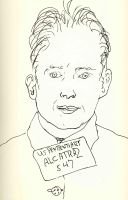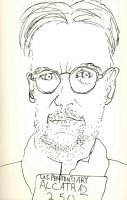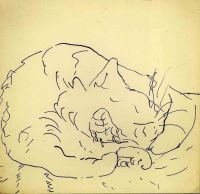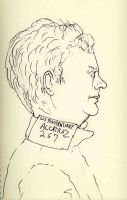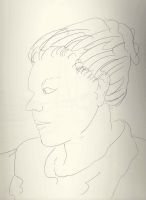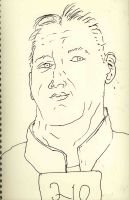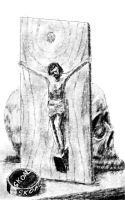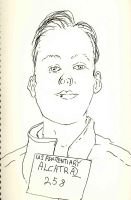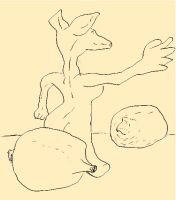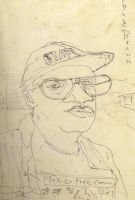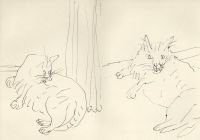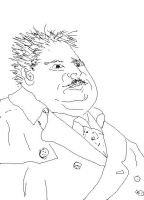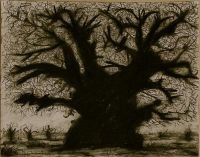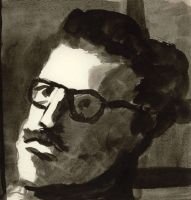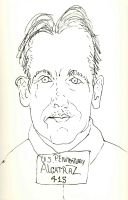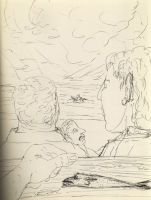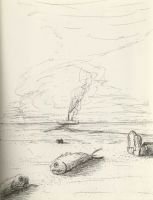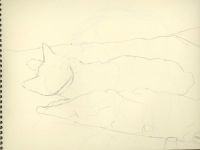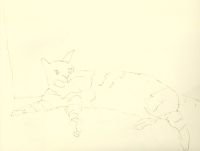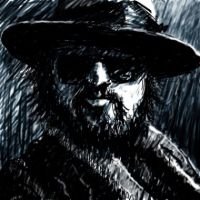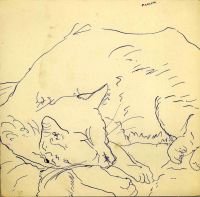Introduction: A Line Between Worlds
In the sketchbook gallery of stmcgurin, drawing is more than a medium—it’s a method of sense-making. Across 141 images spanning eight distinct sketchbooks, this artist’s work invites viewers into a visual language that’s raw, gestural, and deeply observant. Whether rendered in ink, pencil, pen, or ballpoint, each piece carries the unmistakable signature of someone who sees with clarity and draws with freedom. The result is a gallery that feels both intimate and expansive, where loss of line becomes a gain in truth.
Alcatraz: Mug Shots and Memory
The “alcatraz” sketchbook opens with stark portraits—prison mug shots drawn in ink on yellow or newsprint paper. These faces, stripped of context and suspended in time, are rendered with a line that’s both clinical and compassionate. There’s no caricature here, only the quiet tension of identity under surveillance. The ink bleeds slightly into the paper’s fibers, echoing the way memory distorts and softens even the harshest realities. Each drawing feels like a fragment of a larger story, one that the viewer must piece together from expression, posture, and the artist’s unwavering gaze.
Cats: Gesture and Whimsy
In “cats,” stmcgurin shifts tone but not technique. These loss line drawings, done in pencil and ink on yellow or newsprint paper, capture feline motion with a kind of playful reverence. The cats are never static—they stretch, curl, leap, and lounge in compositions that feel improvised yet intentional. There’s a looseness to the line that suggests speed and spontaneity, but also a deep familiarity with the subject. These aren’t generic cats—they’re lived-in, observed, and remembered. The sketchbook reads like a diary of encounters, each page a moment of connection.
Fish-World: Ballpoint Narratives
“fish-world” is where stmcgurin’s storytelling instincts come to the fore. Using ballpoint, pencil, and ink, the artist sketches fish not as specimens but as characters. Some are rendered with anatomical precision, others with surreal exaggeration. The medium itself—ballpoint—adds a layer of grit and immediacy. It’s a tool of everyday writing repurposed for visual myth-making. The fish swim through imagined currents, sometimes alone, sometimes in clusters, always with a sense of motion and mystery. There’s humor here, too, in the way certain fish seem to smirk or pose, as if aware of their role in the narrative.
Landscapes and Still Life 1: Circus, Beaches, and the Bebob-Tree
This sketchbook is a departure—a more expansive, story-like collection that includes circus scenes, beachscapes, and a fantastical “bebob-tree.” The line remains loose and expressive, but the compositions grow more layered. The circus sketches are particularly evocative, capturing not just performers but the atmosphere of spectacle and strangeness. Beaches are rendered with a kind of nostalgic softness, while the bebob-tree stands out as a surreal anchor—part botanical, part musical, entirely imagined. These drawings feel like memories filtered through dream logic, where every detail is both specific and symbolic.
Portraits and Figures: Flow, Exaggeration, and Motion
Across “portraits,” “portraits-and-figures-1,” and “portraits-figures-2,” stmcgurin explores the human form with increasing abstraction. The ink line is close-up, often focused on the head, and always gestural. There’s a sense of motion in every stroke—faces tilt, eyes dart, mouths open mid-thought. In the figures, exaggeration becomes a tool for truth. Limbs stretch, torsos twist, and postures defy gravity, all in service of capturing essence over anatomy. These drawings aren’t about likeness—they’re about presence. The artist’s hand is visible in every mark, and the viewer is invited to follow its path.
Sketchbook-02: Kangaroo Puppets and Still Life Oddities
“sketchbook-02” is perhaps the most enigmatic of the collection. Here, stmcgurin presents a series of still lifes featuring a strange upright kangaroo puppet, a skull, and an old iPod. The variations suggest experimentation—different angles, lighting, and emotional tones. The juxtaposition of organic and digital, puppet and relic, creates a tension that’s hard to resolve. Is the kangaroo a stand-in for something else? Is the skull a memento mori or just another object? The iPod, now obsolete, adds a layer of temporal dissonance. These drawings are quiet puzzles, each one asking more questions than it answers.
Conclusion: Drawing as Perspective
For stmcgurin, drawing is not just a practice—it’s a perspective. The sketchbooks are not polished portfolios but living documents, each page a negotiation between observation and expression. The artist’s statement—“Drawing helps me make some kind of sense in this world”—rings true throughout the gallery. There’s no pretense here, only presence. Whether sketching prisoners, cats, fish, or puppets, stmcgurin draws with a line that sees clearly and moves freely. It’s a gallery that rewards close looking and invites repeated visits.
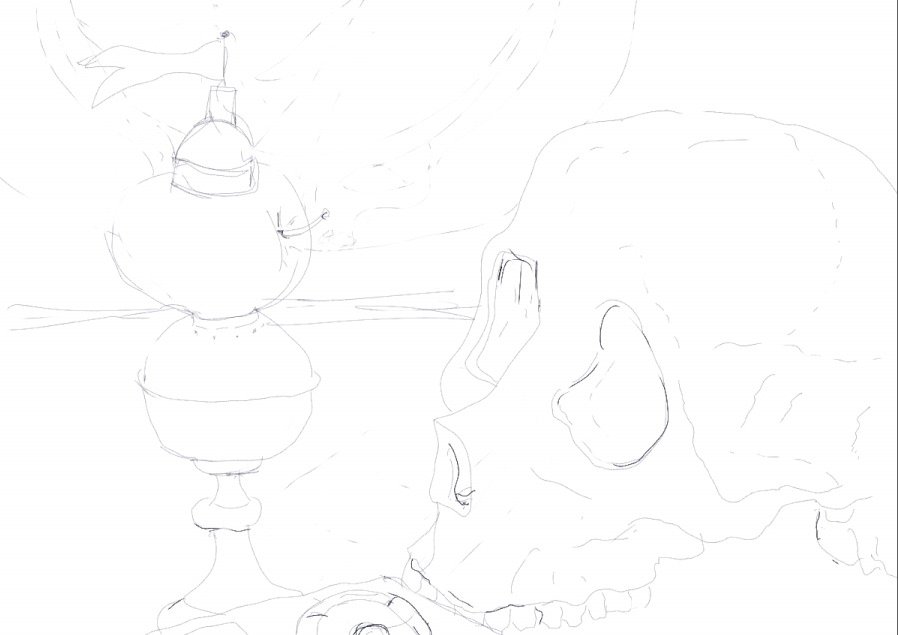
Ready to Share Your Work?

